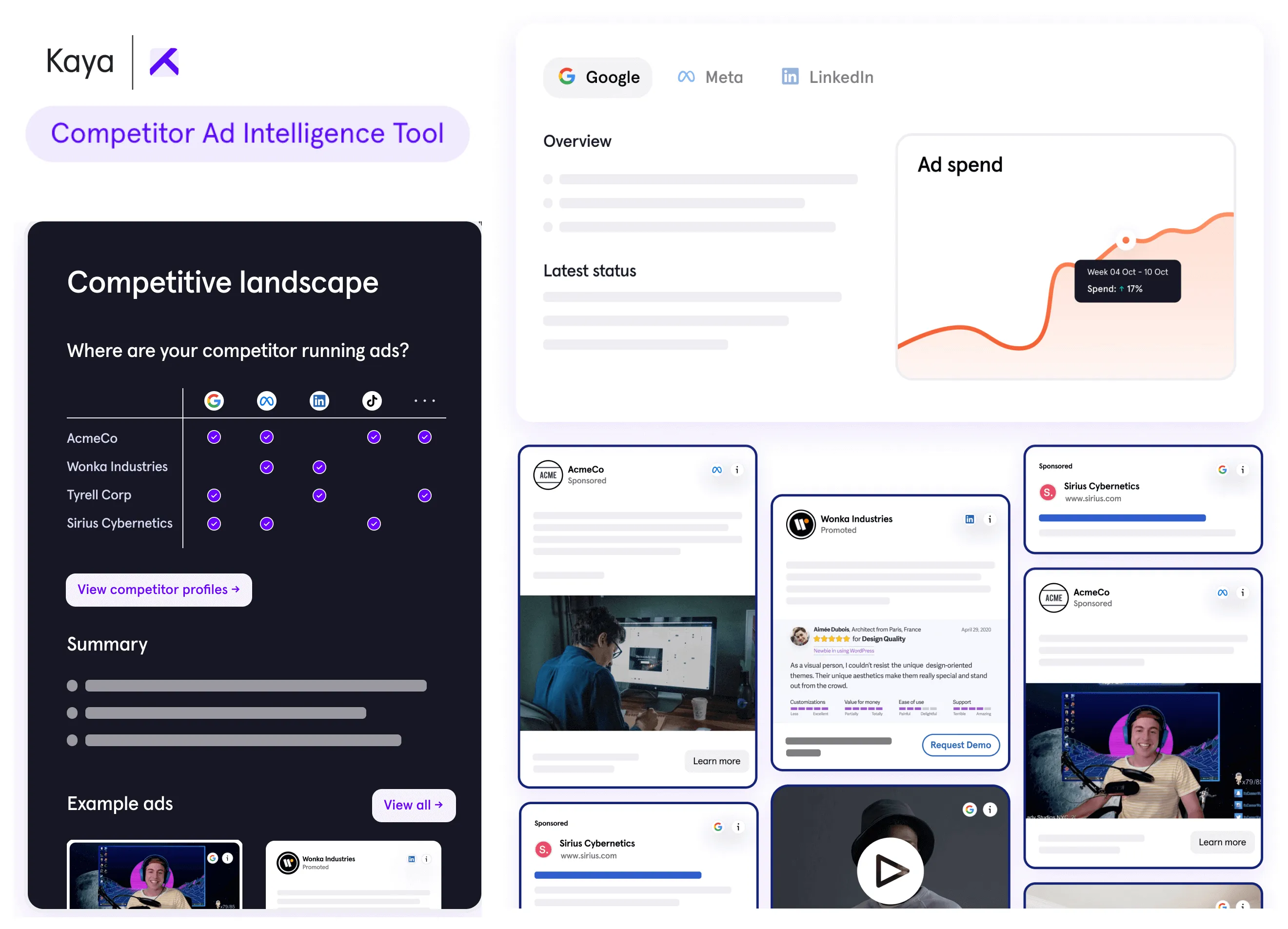Google estimates its ads to deliver an 800% ROI, conversion rates of 3-6%, and an increase in brand awareness by up to 33%. The data speaks for itself - If you're not already leveraging this powerful platform, it's definitely worth considering for your marketing mix.
But maximizing your results goes beyond just starting a campaign. Find competitor ads, analyze them, and use the insight to fine-tune your ad strategy. In this post we’ll be covering the step-by-step guide and relevant tools to find competitor ads for your Google Ads competitor analysis.
What is Google Ads competitor analysis?
Google Ads competitor analysis is the process of researching, monitoring, and evaluating how your competitors are advertising on Google Search, Google Display Network, YouTube, and Google Shopping. The goal is to uncover what keywords they target, what their ads look like, how much they might be spending, and what offers or landing pages they use — so you can make smarter decisions with your own paid search strategy.
What does a Google Ads competitor analysis include?
A complete analysis typically covers:
- Search keywords competitors are bidding on
- Ad copy and headline styles they use in search or display
- Landing pages they drive traffic to
- Estimated ad spend and impression share
- Ad formats (text, responsive, shopping, video) and frequency
- Audience targeting strategy, if detectable
- Offer positioning and CTAs
Why it is important to analyze competitor Google Ads
Analyzing competitor ads is crucial for startups to enjoy successful paid ad campaigns. Here are other reasons to analyze competitor ads.
- Identify market trends: Analyzing competitor ads helps you identify the current market trends, allowing you to create more appealing and relevant campaigns.
- Benchmark performance: If you find competitor ads on Google, you can benchmark your ads' performance and make necessary improvements.
- Discover creative ideas: Your competitors' Google Ads can inspire new, innovative ideas that you can incorporate without copying.
- Gain insight into target audience: Analyzing your competitor's ads shows who they are targeting, giving you a new perspective on your target audience.
Types of Google Ads
Google offers several ad formats, depending on the type of campaign you choose. Your Google Ads will usually be in one of these formats.
- Video ads
- Banner ads
- Text format search engine ads
- Display ads
Important Google Ads metrics
Google Ads metrics help you evaluate campaign performance and improvement for better results. The following are some of the most important metrics to track:
- Click-through rate (CTR): This metric measures the ratio of clicks to impressions, indicating the relevance and effectiveness of your ads.
- Conversion rate: This is the percentage of clicks that lead to conversion. It reflects the performance of your landing page.
- Cost per click (CPC): Indicates the average amount you pay for each click. It helps you manage budget and bidding strategies.
- Return on ad spend (ROAS): Estimates the revenue generated for every dollar spent. It assesses the profitability of your ad campaigns.
- Cost per conversion: Measures the average cost of achieving a conversion. It is a vital metric for ad performance monitoring.
Tools for finding and analyzing competitor ads on Google
- Kaya’s Competitor Ad Intelligence Tool: Kaya's Competitor Ad Intelligence Tool allows you to track all your competitors' ads. It organizes everything in one place, easing your marketing decision-making.
- Google Ads Transparency Center: Google’s native tool allows you to view competitors' ads, ad creative and other ad elements for free.
- SpyFu: SpyFu’s competitive analysis tool allows you to research competitors' PPC campaigns.
You can also use other tools for Google Ads competitive analysis, such as Semrush’s PPC toolkit, advertising research tool, and AdFlex.
Step-by-step guide to Google Ads competitor analysis
- Know your competitors: Use keyword research tools to identify bids on keywords similar to yours. Also, search on Google to see who else is ranking for your primary keyword. You may also conduct industry analysis to identify your competitors.
- Conduct keyword research: Use tools like Ad Auction Insights, SEMrush and other keyword research tools. You will get insights on keyword relevance, volume, competition, and CTRs.
- Analyze ad copy: Once you start the analysis, look at USPs, message themes, and emotional triggers.
- Analyze the landing page: Next, evaluate the landing page and look out for the flow from the ad to the landing page, design and layout, including visual elements, and also CTAs.
How to find competitor ads on Google with various tools
There are many tools to find competitor ads on Google, but here are the most cost-effective and efficient ones to do it. Combine the below tools for the best results.
Use Kaya’s Competitor Ad Intelligence Tool
Kaya’s Competitor Ad Intelligence Tool is built for startups and allows you to know what your competitors are up to quickly. It offers deep insights into competitors' activities on various ad channels. It also allows you to:
- Get a top-down view of all your competitor's ad performance
- See your competitor's ad spend and effort per channel
- Discover new and more targeted customer profiles
The best part? Integrates your existing data and gathers all the ad insights in one place. You make better decisions faster than ever. It also recommends viable channels, ideal ad spending, and suggestions on new marketing angles to engage your audience.

Kaya's Competitor Ad Intelligence Tool shows you where your competitors are running ads; how much they're spending; which ad formats are working for them.
Use the Google Ads Transparency Center
The Google Ads Transparency Center allows you to see your competitor's Google Ads in three easy steps.
- Go to the Transparency Center and enter your competitor’s name in the search bar.
- Click on their name once it comes up, and you will be able to view their recent ads.
- Click on individual ads to see more ad variations.
Insights from the ads let you know what keywords your competitors are bidding on. You can analyze the headline and description or view your competitor’s ad copy. You can also see the multimedia elements. Check ad publishing dates to understand their timing and frequency. Then, compare with yours to see what you can improve.
Find your competitor ads on Google Search
You can find and analyze your competitor’s ads using the Google search engine. Search any of your competitors or one of their keywords. You may see one of their ads on the search results page. Then, do the following:
- Click on the three little dots next to the ad, and you will find more of their active Google Ads.
- Click on See more ads’ after the ‘My Ad Center’ page opens—this opens up the ads, allowing you to spy on your competitors.
You will find different ad formats on the ‘My Ad Center’ page. You will also see the ad locations, and there is an option to adjust the time period, giving you a more detailed view. For best results, use the incognito mode. You can use this method to analyze competitor ad headlines, CTAs, and more.
Find competitors’ Google Ads using Auction Insights
If you're running Google Ads, Google provides Google Ads Auction Insights reports that allow you to track your performance versus others. So, go to the search auction insights to see your ad performance compared to others competing in the same auctions.
It provides data on impression shares, position above rate, and top-of-page rate, among others. This data allows you to know what to bid or budget to improve your ad performance. Follow the below steps to access the report.
- Go to your Google Ads account and select campaign, ad group, or keyword.
- Click on 'Auction Insights'.
- Review the competitors you find in the report.
- Check key metrics such as average position, impression share, and overlap.
There's a great chance you will find the ads of your known competitors. You will also find ads from other businesses that you haven't considered as your competitors. Record their activities and check in often to stay up to date.
[Bonus] Find competitor keywords using Google’s keyword planner
Most startups that use Google's keyword planner tool use it to find their own keyword ideas. You can use it to find competitor keywords, and it's simple.
Instead of your URL, plug your competitor's URL into the search bar. You will find a list of keywords, some of which may be new to you. They come from your competitor's website. List them and move to other tools for deeper analysis.
Analyzing competitor ads data
When you find competitor ads on Google, you proceed to analyze them. But what should you be looking for?
- Analyze ad performance metrics: Review your competitor's performance metrics, like click-through rates (CTR) and conversion rates. That way, you can understand the strengths and weaknesses of their ad strategy.
- Understand bid strategy and keyword bidding: Analyze your competitors' bid strategies and keyword bidding patterns. Check the budget allocation across keywords to increase ad performance and visibility.
- Evaluate competitor's paid search campaigns: Review competitor's paid search campaigns to see their targeting, ad copy, and landing pages. Identify effective tactics and gaps to improve your paid search positions.
Best practices for Google Ads competitive analysis
- Focus on your competitors’ display ad designs, sizes, and formats.
- Do not forget to conduct detailed keyword research.
- Follow industry trends and changes in competitor strategies.
- Always monitor and analyze your competitors’ ad performance.
- Test and iterate based on insights from your analysis.
Strategies to improve your Google Ads
The entire point of analyzing your competitor’s Google Ads is to get insights that you can leverage to refine your ad campaigns. Here are some strategies to consider.
- Implement insights from competitor analysis tools: Use insights from tools like Kaya’s Competitor Ad Intelligence Tool to identify successful competitor tactics. Then, use their successful tactics to improve Google Ads strategy.
- Strengthen ad campaigns based on competitor data: Analyze your competitors' campaign performance metrics and keyword strategies. Adjust your keywords, ad copy, and landing pages to improve engagement and CTR.
- Adjust bid strategy and target for better results: Review your competitors' bidding strategies and audience targeting. Improve your bids to stay competitive and refine your audience targeting. This advertising strategy maximizes your ad visibility and ROI.
Case studies
Abbot
Abbot had questions about their ad strategy, which led them to Kaya for help. The team partnered with them, relying on Kaya's marketing expertise and data-driven operations to improve their results.
Kaya has been helping us out with some marketing as well, and they have been AMAZING to work with. Highly recommend talking to them!
Safely Finance
Safely Finance also experienced the data-driven approach and marketing expertise of the Kaya team. With Kaya’s AI-powered tools, they delivered insights and campaigns that led to Safely Finance’s Google Ads conversion growth of 651%, 3 times key conversion points increase, and an 80% drop in cost offer.
By trusting Kaya and delegating, we regained time to spend understanding our users.
FAQ
How do I find competitors on Google?
Where can I see Google Ads performance?
How to analyze competitor Google Ads?
Can you see how much your competitors spend on Google Ads?
Can Google Analytics be used for competitor analysis?
Final thoughts
Advertising on Google offers great ROI. It also improves brand awareness. These are metrics that matter to your startup. By following the strategies and using the tools outlined, you can find competitor ads for competitor ads analysis.
Above all, Kaya’s Competitor Ad Intelligence Tool enables you to cut through the noise and get straight to the insights. That way, you can improve your ad strategy, save on costs, and achieve fast results.






